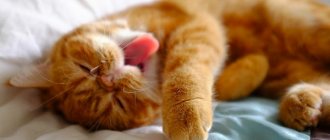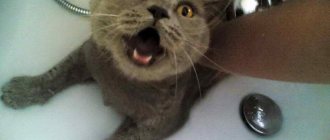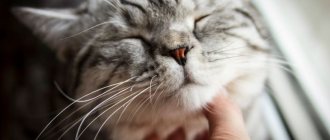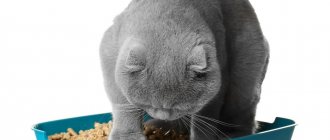Relevance
We cannot explain every special behavior of cats. But this is not necessary: it is part of their charm, and observing their behavior in such situations brings us great pleasure. We humans are never sure if our cats really love us or just want free food and shelter.
So why do our four-legged friends, when they see some objects, completely forget about everything else? Whether it's a regular bag from the grocery store or a cardboard box from your friendly mailman, cats are quick to pounce on these things, making them their new toy, home, or even snack. What is the explanation for this habit? Let's find out.
The benefits and harms of such entertainment
Anyone who has at least once tried to present a cardboard box to their cat will make such gifts again and again. And indeed, they have a lot of advantages for your pet:
- maintain good physical shape;
- psychological state stabilizes;
Kittens get used to boxes from the very first days of their lives, which is why they help the animals calm down.
- the cat doesn’t get bored and doesn’t scratch furniture or wallpaper;
- Problems with a place to sleep and play are solved without much expense.
The cat bed problem is very easy to solve.
The cat is warm, cozy, calm and interesting in this life-saving box made of the most ordinary packaging cardboard. Even very small kittens in such a shelter perceive their new living conditions much more easily and get used to them faster.
There are few disadvantages, but they exist. Don’t chase beauty - a bright multi-colored box can be dangerous, especially for animals prone to allergies. Modern printing, unfortunately, often uses toxic inks - if a cat tastes such cardboard, it can get sick. Banal corrugated cardboard boxes are much safer, even if they are not very beautiful.
However, even with such harmless cardboard, a cat is quite capable of clogging its stomach - if, after playing too much, it chews off too much of it. Watch the animal and do not allow it to do this.
The smell of food
First of all, we want to assure you: when faced with incomprehensible behavior of a pet, you should not assume that he has rabies. In this state, the cat will rush at the person, and not at the box or plastic bag.
Scientists and pet lovers alike have several theories as to why kittens go crazy over these items. One of the most obvious explanations is that these bags or boxes previously contained food. Cats have a keen sense of smell (much stronger than that of any human), so it is not surprising that they can sniff the entire package that, for example, previously contained a frozen salmon fillet. Additionally, many of these bags are coated with natural material (such as cornstarch) and some are even made from animal by-products (gelatin). All this makes such items especially attractive and tasty.
Is the cat attracted to other objects?
The pet industry offers a huge range of different houses for cats. They look beautiful and original, they are not cheap, but they often delight the owners themselves more than their pets. The same goes for exquisite baskets, beds and other fashionable attributes that fit better into the interior than into a cat’s life.
Most cats themselves choose objects, sometimes quite unexpected for humans, which they then happily use as a house, a crib, a place to rest, ambush, meditate, or whatever. And there’s nothing you can do about it: every cat at heart is an artist, a creative person.
Photo gallery: “cat house” in the most unexpected place
A suitcase is no less interesting for a cat than a box
Puss in Boot - this is what it really looks like
Cats are like liquid and can fit anywhere.
The stump is even better than the box and reminds us of ancient instincts
A rustling bag is great entertainment for a cat
Domestic cats can be found in the most unlikely places
Video: where cats like to hide
Other sensations
It is also noted that the sound from the bag may remind pets of the noise emanating from rodents when they run through fields or other objects. They understand this: rustling means prey. They can be attracted by various acoustic signals. So don’t be surprised by this behavior of your pet.
Moreover, according to scientific point of view, your pet is a mammal of the cat family of carnivores. So what you are observing is their natural behavior. Cats are small predators, and you shouldn't teach them something like that.
A Brazilian travels 36 km by bike every day to take his loved one home.
The money tree pleases with lush flowering: my secret is in caring for the leaves
Lost weight: what Sofia Tarasova sacrificed for the sake of “VIA Gra” (new photos)
Another interesting detail is that if you take a closer look at the texture of the bag, you can see that they might like its cool, smooth surface. All this attracts these creatures, regardless of whether they lick the object or simply play with it.
Cat hiding places in nature
For a person, a box is a capacious container and nothing more. For a cat, a box is a real refuge.
The box is a shelter for cats
All modern cats, both purebred and stray, have a wild forest cat in their ancestors. This is a fairly large fluffy animal, a dexterous hunter that attacks not only birds and rodents, but even roe deer, competing with lynx.
The wild forest cat is found in European and Caucasian deciduous forests. A wild cat has excellent hearing and vision, but its sense of smell is a little weaker, and it is impossible to be on guard 24 hours a day. Of course, she does not build houses for herself and does not dig holes, but she willingly takes refuge from bad weather and enemies under fallen trees, in hollows, abandoned fox and badger holes. Even a dense interweaving of branches, a rocky depression, a densely overgrown island in a floodplain, or a small hole will do. A wild cat is unlikely to sleep on an open lawn - it will climb higher on a tree or hide.
Interesting research
Scientists from a university in Utrecht (Netherlands) studied the benefits of such boxes for two groups of newly arrived cats. What was the essence of the study? One group of animals had the opportunity to hide in their own boxes, while the other did not. What was the outcome? Not surprisingly, those pets who were able to hide in boxes experienced significantly less stress (after all, they were able to relax better), felt more comfortable in their surroundings and were more interested in interacting with people than cats who did not have boxes.
“We are still friends”: Derevianko commented on the breakup with his wife
A student at the Vietnam Police Academy shared how she takes care of her facial skin.
It’s good to wash often: myths about shampoo and hair care that only harm
Pets often look for a secluded place: in their understanding, a box is exactly the object in which they can retire. It is noteworthy: the tighter the box, the more desirable it becomes for cats.
Asylum
Cats are solitary animals by nature, but living with humans forces them to exist in society. Every day they experience mild stress from the need to communicate with the owner and his family, his dog or even other cats. Cats are sensitive to stress, any noise, changes in their daily routine make them nervous, and there’s nothing to say about moving or a visit to the veterinary clinic!
The box is an enclosed space, and being inside helps the cat relax and feel safe. If there is no cardboard box, cats hide on a shelf of a closet with clothes, inside the drum of a washing machine, in a carrier or a special cat house. Not only do they not suffer from claustrophobia, but they also welcome secluded corners in every possible way.
This may seem strange, because in nature cats do not live in burrows. However, it has been proven that wild cats make their lair in the hollows of old trees, badger holes or in piles of windfall. For a domestic cat, a box is its safe cave.
When the size of the box does not allow you to get comfortable, the cat looks very funny. How could she be comfortable in such an awkward position, in cramped conditions? It turns out that it can. Even an uncomfortable box is better than nothing, because it is an effective anti-stress for a cat.
Warm
The boxes also attract four-legged creatures by providing warmth when it gets too cold outside. Cats can't just put on a sweater when the temperature drops, so don't be surprised if they seek warmth in unusual places. Cardboard is an excellent insulator. Whether your cat is stressed, mildly ill, or just looking for a comfortable place to feel safe from predators (perhaps your neighbor's dog), a box is a very suitable item.
The principle “If it fits, I sits” (“If I fit, I’ll climb”)
Attentive observers will note that in addition to boxes, many cats choose other strange places to rest. Some curl up in the sink. Others prefer shoes, bowls, bags, coffee mugs and other small, confined spaces.
This brings us to another answer to why your cat likes very small boxes (and other seemingly awkward places): it's cold.
According to a 2006 study by the National Research Center, the thermoneutral zone for a domestic cat is 30 - 36 degrees Celsius. This is the temperature range in which the cat is comfortable and does not need to generate additional heat to stay warm or expend metabolic energy to cool down. This range is 10 degrees higher than ours. That's why it's not uncommon to see a cat stretched out on the hot pavement in the middle of a hot summer day, enjoying the sun's rays.
This also explains why many cats like to curl up in tiny cardboard boxes and other strange places. Corrugated cardboard is an excellent insulator and helps your cat retain body heat.
The same study found that the temperature of most cats' living areas is approximately 22 degrees Celsius, which is 14 degrees less than their thermoneutral temperature.
So, the answer has been found: boxes are heat-insulating, stress-relieving zones; places where cats can hide, relax, sleep, and sometimes ambush the huge, unpredictable monkeys they have to live with.
Paper
Crumpled paper, often used as packaging material, can also be a cat's best friend. Don't be upset if you spent a decent amount of rubles on a beautiful cat house, but your pet prefers your newspaper or wrapping paper to it. This doesn’t happen often: apparently, they simply enjoy the process itself.
Maybe they are trying to get your attention with this behavior, or perhaps they want to mark their territory. Or is it a new item in the house that needs to be explored in more detail. Dangling objects seem to remind cats of hunting. In fact, there is no end to the speculation as to why your cat chose paper.
How cats love boxes
As soon as any box enters the cat's field of vision, an exciting show immediately begins. The cat, having abandoned his past activities, switches to a banal packaging container and shows interest in it in every possible way: he sniffs it for a long time and carefully, tries it “tooth and nail,” and then always tries to fit into this very box, even if it does not at all correspond to his dimensions.
The small dimensions of the boxes do not bother large cats at all - in cramped conditions, as they say, but no offense
And here’s what’s also interesting: cats, who by nature are fierce individualists, often don’t mind at all sharing the territory in the coveted box with their relatives. The housing problem, it turns out, did not spoil them - in such a “communal apartment” the cats coexist quite peacefully.
The cats' housing problem hasn't ruined them - they're ready to share the box
Such a strange passion has long been noticed by both scientists and employees of zoos or safari parks - where predatory cats are often provided with quite affordable entertainment that they adore. Everyone is happy, everyone enjoys it: both the animals and the spectators.
An ordinary box can reconcile even the most terrible predators
Photo gallery: little secrets of big cats
The box easily turns into a comfortable bedding
Wild cats also share a passion for boxes.
Zoo staff often give felines boxes as gifts.
This everyday item is of constant interest to cats.
Video: box for the king of beasts
Conclusion
Cats' actions may always remain a mystery to us, but this is part of their charm. Of course, if any of the above actions seem repetitive or out of control, you may want to contact your veterinarian.
Remember: eating non-food products (bags or other garbage) can lead to intestinal blockage, and therefore you should not neglect this phenomenon. But often the explanations for the behavior of four-legged creatures are quite simple: the box and package can attract smells, acoustic signals or the heat emanating from them.
Found a violation? Report content
Why do they chew packages?
Plastic packaging attracts pets no less than cardboard packaging. There are times when a pet furiously tears a plastic bag with its teeth. This does not mean that he lacks any substances or is sick. Not at all: if you are sick, have a vitamin deficiency or feel unwell, the cat is not interested in the bag. The animal entertains itself this way, because, you see, the owner often pays too little attention to it.
The cat begins its play by rustling and often by tossing a package. While entertaining herself, she may give in to her predatory instincts, similar to those when she plays with a mouse. Other individuals like the way their claws dig into the polyethylene. If the cat seriously chews or even eats the bag, most likely there was something edible in it, which left an attractive smell for it. For the same reason, the cat licks bags.
Why do they play with cellophane?
Cats are naturally extremely curious and interested in everything. They love the rustling sound; some members of the family like to inspect every package they see in the house. They can climb into them, sit inside for a long time and be sincerely offended when they are scolded for this. Cat nature is such that furry pets look at everything in their own way. Sometimes breeders jokingly note that their pets were born in bags - they are so attracted to them. Moreover, cats sometimes not only play with bags, but even go to sleep in them.
Plastic bags are different from conventional toys. During play, they not only rustle, but also magnetize the wool when they come into contact with it. Cats love everything unusual, giving free rein to their instincts. In addition, they may associate the sound of a rustling package with a call to hunt.
Being in a playful state, the cat can play along with itself by tossing the bag or trying to touch it as often as possible in order to hear an interesting rustling sound again and again.











